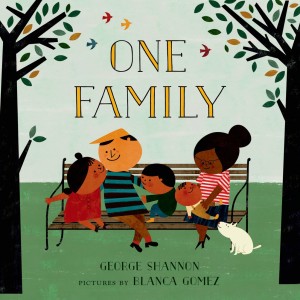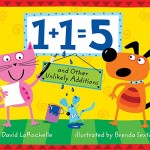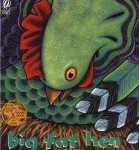“One Family” is one you need for Thanksgiving!
 Thanksgiving is my favorite holiday, but it’s a challenge to find Thanksgiving picture books that connect with kids (I find many “pilgrim and Indian” books that are cringeworthy with stereotypes). This year, I’m focusing on the “thanks” in Thanksgiving and sharing One Family by George Shannon with pictures by Blanca Gomez.
Thanksgiving is my favorite holiday, but it’s a challenge to find Thanksgiving picture books that connect with kids (I find many “pilgrim and Indian” books that are cringeworthy with stereotypes). This year, I’m focusing on the “thanks” in Thanksgiving and sharing One Family by George Shannon with pictures by Blanca Gomez.
The simple counting book is elevated here to show the beauty of what a family can be.
Counting up to ten, we see all kinds of inclusive loving groups: two dads and their daughter (all with different shades of skin), grandparents and kids, a family where the dad and his sons are wearing turbans, a mix of adults and kids where it’s not clear what the relationships are but who cares because they’re smiling and together. On the last page showing all the people we read, “One is one and everyone. One earth. One world. One family.”
Use this book to inspire your students to write and draw about their own families. To continue the counting 1 to 10 structure, students can write about what they are thankful for this holiday. Pair this with the wonderful new nonfiction book Families by Shelly Rotner and Sheila M. Kelly if you want to compare and contrast to hit the Integration of Knowledge & Ideas standard. I count you among my many blessings!
Read More27 Books You Can Use This Year
During the “Moving Beyond the Basics… Reaching for More” conference on Aug. 11 at the Byron Center High School in Michigan, a roomful of teachers and I read through boxes of books. (Thank you, Annemarie Johnson and Kate DiMeo, for inviting me to share informational picture books and to talk about kids’ book publishing.) ((Have I mentioned that my first picture book, GROUNDHOG’S DILEMMA, will come out this December 1 from Charlesbridge?)) After browsing and brainstorming, we generated a list of 27 books with lesson ideas we can use this year in kindergarten through third grade. Feel free to share it!
| Title | Author | Illustrator | Lesson Ideas |
| Alphabeasties and Other Amazing Types | Werner Sharon | Forss, Sarah | alliteration, identifying letters in different fonts – visual learners |
| Aunt Ant Leaves through the Leaves | Coffelt, Nancy | homonyms/homophones | |
| Bee Dance | Chrustowski,Rick | vocabulary, informational reading, chronological text structure, debate if it is “narrative” or “informative” | |
| The Best of Times | Tang, Greg | Briggs, Harry | multiplication in third grade, rules for each and tables |
| Boy, Were We Wrong About the Weather! | Kudlinkski, Kathleen V. | Serra, Sebastia | compare/contrast what we once thought to what we now think, text features, weather in first grade, landforms in second |
| Families | Rotner, Shelley | Rotner, Shelley | “all about” writing at a simple level = great mentor text |
| Greedy Apostrophe: a cautionary tale | Carr, Jan | Long, Ethan | grammar – ways to use an apostrophe |
| Henry’s Map | Elliot, David | mapping skills lesson, pictures with labels = text feature, mentor tex for writing | |
| How To Surprise a Dad | Reagan, Jean | Wildish, Lee | mentor text for “how to” writing that goes beyond basic instruction format, mentor text for incorporating all five senses in details |
| In Mary’s Garden | Kugler, Carson | Kugler, Tina | compare/contrast with “The Most Magnificient Thing” |
| The King Who Rained | Gwynne, Fred | homonyms/homophones/word play, figurative language | |
| Lucky and Stu vs. the Mikanikal Man | Van Wright, Cornelius | reading for pleasure! Friendship themes and good “boy” book | |
| Math Fables | Tang, Greg | Cahoon, Heather | number sense for youngers |
| Me, Too! | Dunklee, Annika | Smith, Lori Joy | opinion writing: “Reason #1”, friendship story to discuss |
| Messy Jesse | Bowles, Paula | writing prompt, “what I’m good at”, punctuation lesson | |
| Nino Wrestles the World | Morales, Yuyi | using context to decode unfamiliar words, appreciation of other languages/cultures | |
| One Boy | Seeger, Laura Vaccaro | finding words within words | |
| One Word from Sophia | Averbeck, Jim | Ismail, Yasmeen | persuasive writing, writing for an audience, text features like glossary |
| Ostriches Are Not Pets! | Niver, Heather Moore | persuasive writing | |
| Over in the Wetlands | Rose, Caroline Starr | Dunlavey, Rob | vocabulary – word choice and author’s craft, context clues, inferring, how do animals prepare for storms compared to how people prepare? |
| Rufus Goes to School | Griswell, Kim T. | Gorbachev, Valeri | use at the beginning of the school year, shows importance of learning how to read, point out persuasive reasons why pigs should (not) go to school |
| Simple Machines | Adler, David A. | Raff, Anna | use as a mentor text for flip books, compare/contrast, nonfiction with illustrations and not photos, text features, easy nonfiction that’s not about animals |
| Speed, Speed, Centipede! | Dahl, Michael | Trover, Zachary | early math counting by tens, shows 10 frames |
| This Plus That: Life’s Little Equations | Rosenthal, Amy Krouse | Corace, Jen | writing with math symbols |
| Water is Water | Paul, Miranda | Chin, Jason | “show, don’t tell”, art tells story as much as text does |
| Wumbers | Rosenthal, Amy Krouse | Lictenheld, Tom | lesson on speech bubbles |
| Zero the Hero | Holub, Joan | Lictenheld, Tom | higher math concepts, friendship, lesson on speech bubbles |
1 + 1 = a lot of laughs
 Any kindergartner at this time of year will quickly tell you that 1 + 1 = 2, unless it’s a kindergartner who has read this fantastic book 1 + 1 = 5 and Other Unlikely Additions by David LaRochelle and illustrated by Brenda Sexton. The lucky kid who’s read this book knows that 1 + 1 can = 3 if we’re talking about the horns of 1 unicorn + 1 goat. 1 + 1 = 5 if we’re talking about babies (1 set of twins + 1 set of triplets). When does 1 + 1 = hundreds? When we’re counting the seeds in 1 pumpkin + 1 watermelon, a task that would be fun to try with your class after reading this book. Each equation will get kids thinking of combinations of sets in new ways. Challenge your students to write their own 1 + 1 = stumper. Fold a piece of paper in half lengthwise (or hot-dog-wise if you visualize it that way). Set it up so the fold is on top, like a lift-the-flap. Have students write 1 + 1 = and their unexpected number. Lift the flap and show how 1 set of things + 1 set = the combination. Your students will have a ball stumping each other and their parents. 1 great book + 1 class of cool kids = plenty of learning for them and a lot of fun for you.
Any kindergartner at this time of year will quickly tell you that 1 + 1 = 2, unless it’s a kindergartner who has read this fantastic book 1 + 1 = 5 and Other Unlikely Additions by David LaRochelle and illustrated by Brenda Sexton. The lucky kid who’s read this book knows that 1 + 1 can = 3 if we’re talking about the horns of 1 unicorn + 1 goat. 1 + 1 = 5 if we’re talking about babies (1 set of twins + 1 set of triplets). When does 1 + 1 = hundreds? When we’re counting the seeds in 1 pumpkin + 1 watermelon, a task that would be fun to try with your class after reading this book. Each equation will get kids thinking of combinations of sets in new ways. Challenge your students to write their own 1 + 1 = stumper. Fold a piece of paper in half lengthwise (or hot-dog-wise if you visualize it that way). Set it up so the fold is on top, like a lift-the-flap. Have students write 1 + 1 = and their unexpected number. Lift the flap and show how 1 set of things + 1 set = the combination. Your students will have a ball stumping each other and their parents. 1 great book + 1 class of cool kids = plenty of learning for them and a lot of fun for you.
Why Nursery Rhymes Work
 I had the pleasure of attending a kindergarten “family night” at an elementary school. The theme was nursery rhymes, and once again I was reminded why these rhymes are so powerful. I could (and often do) go on for days about the phonological awareness that rhyme builds, how children who are read to are exposed to thousands more words than those who hear only daily conversation and television, how we learn words best in meaningful context and how the rich language of nursery rhymes develops a child’s vocabulary, but I know I’m preaching to the choir. Instead, allow me to share with you one of my favorite nursery rhyme books, Big Fat Hen by Keith Baker. This is my go-to nursery rhyme book for littlest listeners, and all my students who are building number recognition feel like rock stars because they can read this so easily. The pictures are huge, perfect for a group share, and the text is quickly read to wiggly ones.
I had the pleasure of attending a kindergarten “family night” at an elementary school. The theme was nursery rhymes, and once again I was reminded why these rhymes are so powerful. I could (and often do) go on for days about the phonological awareness that rhyme builds, how children who are read to are exposed to thousands more words than those who hear only daily conversation and television, how we learn words best in meaningful context and how the rich language of nursery rhymes develops a child’s vocabulary, but I know I’m preaching to the choir. Instead, allow me to share with you one of my favorite nursery rhyme books, Big Fat Hen by Keith Baker. This is my go-to nursery rhyme book for littlest listeners, and all my students who are building number recognition feel like rock stars because they can read this so easily. The pictures are huge, perfect for a group share, and the text is quickly read to wiggly ones.
One of the best parts of the kindergarten family night for me was seeing how successful the students felt as they read nursery rhymes to me from books and off of posters. Because of the short, rhyming text, nursery rhymes are easily memorized, so those who are still developing word recognition and decoding skills can feel successful as they “read” from memory the rhymes. I brought a pretend candlestick (a toilet paper tube wrapped in construction paper with a red tissue paper flame which is as crafty as I get) and had students act out “Jack Be Nimble” after we read the rhyme. Amazingly fun and super-easy, make a poster of the rhyme, have 3×5 cards with your students’ names to tape up over the word “Jack”, and let your little ones be part of the rhyme.
Read More








